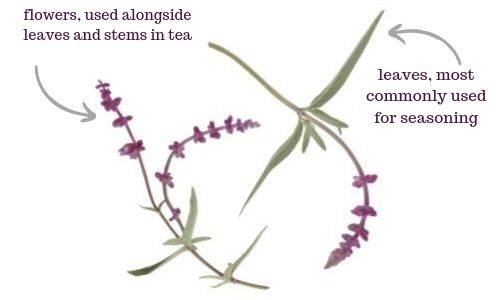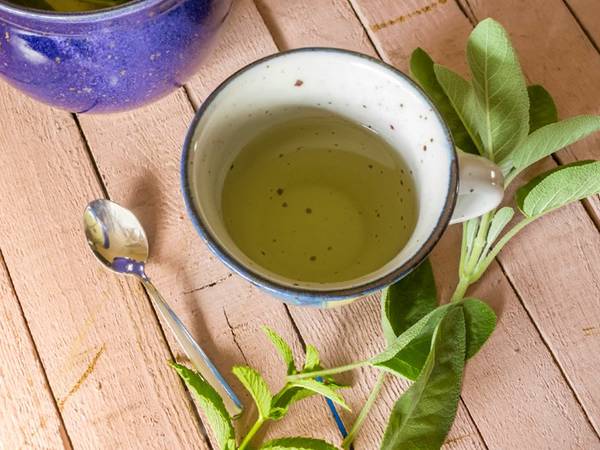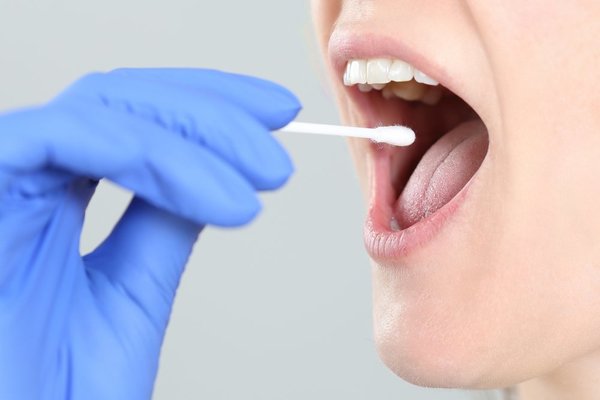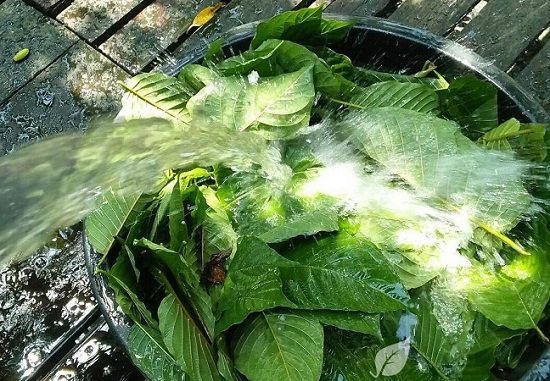Salvia belongs to the same family as mint, the Lamiaceae family, with its origin in Mexico. All of you must be aware of mint leaves, but some of you might also be knowing about Salvia or must have heard about Sage.
Salvia divinorum is the only extraordinary species of Salvia which is now gaining more popularity. With tons of data available online, it’s essential to know the right information and correct usage of this plant.
Therefore, this guide will help you to not only teach ‘How to step by step prepare salvia tea’ but also the tips and tricks to prepare a fantastic cup of salvia tea and even the side effects and precautions.
Last, but no the least, we will make you aware of the legality too, so hold your horses and let’s get on the track!

Making Tea with Leaves, Powder & Extracts
Traditionally, Salvia has many ways of consumption like chewing, smoking, but recently, salvia tea is ruling the salvia world.
Overtime Sage has been made available as fresh leaves, dried leaves, extracts, powder, tincture and capsules, but for making salvia tea, fresh and dried leaves have remained the top choices. Dried leaves can be ground to powder and then be added to the boiling water.
However, the number of equivalents should be kept in mind; for example, seven fresh sage leaves yield one teaspoon of dried, ground sage.
How much Salvia do you need for tea?
We are one step away from knowing the step by step procedure because its crucial to know the quantity of sage required!
The regular drinkers of sage tea have been using variable quantities, adjusting according to their taste and desired effects. You might also want to play around with the leaves or sage extracts until you are satisfied with the results.
Typically, it is recommended to not go beyond 4 to 6 grams of the sage leaf dose per day.
Some prefer to add half an ounce of fresh leaves or equivalent to two of water while others prefer one oz with two cups of water. Preferences differ according to taste and experiences. You may add little or more, as long as you are not overdosing. However, knowing equivalents may help, so here we are:
Tablespoon
fresh chopped sage = 1 teaspoon dried sage=
12 leaves approximately
1/2 ounce of fresh sage leaves = 1/2 cup leaves
1-ounce ground sage = 1/4 cup sage leaves
Ten thin fresh sage leaves = 3/4 teaspoon dried sage
All sorted? Let’s get to the point!
Step by step guidelines
If you are already aware of your kitchen, then all you need to do is gather the following items. The most important step in any recipe is the key ingredients and utensils.
Miss one, lose the taste! So let’s get to work, gather
- One brewing pot.
- 1.5-2 cups or 12 oz of water.
- Half oz of fresh salvia leaves, quarter ounce if using dried leaves.
That’s it! This is the reason preparing salvia tea is an easy task, not tedious at all.
However, there are some optional ingredients to add to the taste, that is:
- Honey
- Milk
- Sugar
- Agave nectar
- Mint Leaves
Procedure
- Boil water in the pot
- Chop salvia leaves
- Dump the leaves in the boiling water (if you are asking about stems, yes! You don’t need to worry about the stems, everything will be strained away in the end anyway, so you can let the stems go into the water); alternatively, the salvia leaves can be packed in the tea bags or tea infusers, in which case straining wouldn’t be required.
- Let the leaves boil in the water for a couple of minutes, approximately 2-3 minutes. Stir in between
- Leave to steep for 7 to 10 minutes.
- With the help of a strainer, pour the pleasant smelling sage tea into serving cups. Make sure all the strained water has no leftover sage leaf.
- Adding lemon/ lemon zest/ honey/ sugar/milk is optional, according to personal preferences.
- Voila, the perfect cup of salvia tea is ready. Breathe the fresh air and sip the mighty tea! You can either drink it hot or let it cool down and drop some ice cubes to get an iced sage tea for a sunny day!
The Traditional Method
Besides, there is another method which is traditionally used by the Mazatec Indians as a religious ritual. In this method, the leaves are not only brewed but also consumed.
However, consuming sage leaves might not please the taste buds of many! People have reported gag reflexes with the consumption of leaves, so beware!
This method of preparing the sage water or salvia tea requires a higher quantity of leaves in the ground form, but it is safe.
According to the University of Pittsburgh Medical Center, an average adult consumer could drink up to 3 cups of salvia tea in a day.
Sage tea benefits
Contrary to the notorious statement about sage, it a beneficial herb for the human body. Undoubtedly, proper usage and accurate dosages should be taken care of, but what does not harm when consumed excessively?
To keep up your morale, we have summed up the potential benefits of sage. Some benefits are known to many, while only a few might recognise the medical-centred effects:
Anti-oxidant and Anti-inflammatory effects
Sage leaves have medicinal significance. Loaded with compounds, such as camphor, carnosol and rosmarinic acid, it imparts anti-oxidant and anti-inflammatory effects.
Improves oral health
Although more research is underway, till date, sage has proven to fight against dental plaque with its antimicrobial properties. This is not what we say; the studies prove it!
Memory
Many of us might be unaware, but recent studies have shown potential protective and beneficial effects on cognition and memory. These effects are attributable to the polyphenol compounds the salvia plants contain.
Effects on cholesterol and diabetes
Salvia has been proven to decrease the bad (LDL) cholesterol, and it increases the good (HDL) cholesterol. Not only that, but it also increases insulin sensitivity, thereby reducing sugar levels and improving diabetes.
Relieves anxiety
It plays a role in alleviating stress in acute settings.
Women Health
In a study, sage showed a decrease in the menopausal symptoms, particularly hot flushes. Also, it helps women who want to reduce their breast milk production.
Digestive Aid
Salvia relaxes the digestive system. Therefore it improves digestion and also relieves diarrhoea and nausea.
Sage tea side effects and precautions
Every action has a reaction!
So, sage leaves can also bag along with some side effects.
Sage, although is approved by the Food and Drug Administration as a spice or seasoning, some of its species may have toxic effects due to higher content of a compound called thujone.
Sage is a dissociative
drug, that is it can put its consumers in a state where they feel to be out of
reality, a sense of detachment from the surrounding, where their perception of
what is virtual or what is real is clouded.
Sage may also cause hallucinations (seeing objects), dizziness, rise in body
temperature disorientation, restlessness, vomiting, tremors, seizures, visual
problems, and kidney damage.
It is due to these effects on the brain; it advised for first-time consumers of Salvia divinorum to have someone around them. This also applies if you wish to try a new higher dosage than usual or a newer method of consuming Salvia.
Salvia officinalis, a specie of sage, is not recommended for those who have seizures. Overall, it’s better to avoid sage if you have a history of seizures.
Salvia has the property of lowering sugar that can be beneficial for diabetics, but on the downside, it may reduce the blood sugar more than required, medically called hypoglycaemia, so beware!
Legality Case
Due to the mild-altering nature of Salvia, its legality remains controversial. In most parts of the globe, it is legal. On the other hand, it has been deemed illegal in certain states whereas in others limited use is allowed.
The United States
In the United States alone, laws regarding Salvia vary by state. For example, the states Delaware, Florida, Indiana, Iowa, Illinois, Kansas, Kentucky, Mississippi, Missouri, Michigan North Dakota, Ohio, Oklahoma, South Dakota, Vermont, Virginia, have regarded it as a controlled substance.
In contrast, Georgia, Louisiana, North Carolina and Tennessee have marked sage illegal for human consumption only. All other states label it legal.
Rest of the world
It is Illegal in:
- Australia
- Belgium
- Canada
- Croatia
- Czech Republic
- Denmark
- Germany
- Hong Kong
- Italy
- Japan
- Latvia
- Lithuania
- Poland
- Portugal
- Republic of Ireland
- Romania
- South Korea
- Sweden
- Switzerland
- Chile (illegal to sell but legal to possess)
- France (illegal to sell but legal to possess)
- Spain (illegal to sell but legal to possess)
- Russia (illegal to sell but legal to possess)
Final Words
Sage, no wonder is a herbal way of getting your mind into the calm zone and dive into a peaceful state while sitting in a dark environment. But it is also noteworthy that it has side effects too.
Every consumer should weigh the effects against the adverse effects. People with health conditions should not try sage if unaware of its impact on them.
Salvia tea has the least effects of Salvia when compared to its other methods of consumption so that no one can overdose fatally with salvia tea!
If you are healthy and crave for a pleasant beverage to calm your mind, it is the right time to step up and get yourself a perfect cup of salvia tea with minimum ingredients and no special kitchen utensils.
Happy brewing!
















